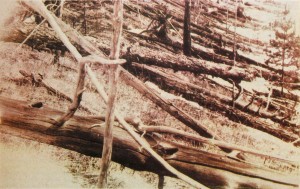Good morning, Whitewater.
June ends for Whitewater with partly cloudy skies and a high of seventy-six. Sunrise is 5:20 and sunset 8:37, for 15h 17m 13s of daytime. The moon is a waxing gibbous with 96.7% of its visible disk illuminated.
Today is the anniversary, from 1908, of the Tunguska (Siberia) event:
The Tunguska event was a large explosion, caused by an asteroid or comet, which occurred near the Podkamennaya Tunguska River in what is now Krasnoyarsk Krai, Russia, at about 07:14 KRAT (00:14 UT) on June 30 [O.S. June 17], 1908.[1][2][3] The explosion occurred at an altitude of 5–10 kilometres (3–6 mi) at 60.886°N, 101.894°E. It is classified as an impact event even though the object is believed to have burst in the air rather than hit the surface.[4] Different studies have yielded widely varying estimates of the impacting object’s size, on the order of 60 m (200 ft) to 190 m (620 ft).[5] It is the largest impact event on Earth in recorded history.
Since the 1908 event, there have been an estimated 1,000 scholarly papers (mainly in Russian) published on the Tunguska explosion. Many scientists have participated in Tunguska studies: the best known are Leonid Kulik, Yevgeny Krinov, Kirill Florensky, Nikolai Vladimirovich Vasiliev, and Wilhelm Fast. In 2013, a team of researchers led by Victor Kvasnytsya of the National Academy of Sciences of Ukraine published analysis results of micro-samples from a peat bog near the center of the affected area showing fragments that may be of meteoritic origin.[6][7]
Estimates of the energy of the blast range from as low as three to as high as 30 megatons of TNT (between 13 and 130 PJ).[8][9] Most likely it was between 10 and 15 megatons of TNT (42 and 63 PJ),[9] and if so, the energy of the explosion was about 1,000 times greater than that of the atomic bomb dropped on Hiroshima, Japan; roughly equal to that of the United States’ Castle Bravo ground-based thermonuclear test detonation on March 1, 1954; and about two-fifths that of the Soviet Union‘s later Tsar Bomba (the largest nuclear weapon ever detonated).[10]
It is estimated that the Tunguska explosion knocked down some 80 million trees over an area of 2,150 square kilometres (830 sq mi), and that the shock wave from the blast would have measured 5.0 on the Richter scale. An explosion of this magnitude would be capable of destroying a large metropolitan area,[11] but due to the remoteness of the location, no fatalities were documented. This event has helped to spark discussion of asteroid impact avoidance.
Here’s Puzzability‘s Tuesday game:
|
This Week’s Game — June 29-July 3
|
|||||
|
One Nation, Divisible
|
|||||
|
Get out your red, white, and blue-ray for this week’s filmfest. For each day, we’ll give you a series of clues, each of which leads to a word. You must drop one letter out of each of these answer words and put them together (in order), adding spaces as needed, to get a movie title that includes a word evoking the July 4th holiday—a different such word every day.
|
|||||
|
Example:
|
|||||
|
“We hold ___ truths to be self-evident” / “Fourscore and seven years ___” / composer of The Merry Widow / public defamation, legally / uninhibited part of the psyche
|
|||||
|
Answer:
|
|||||
|
The Eagle Has Landed (these / ago / Lehar / slander / id)
|
|||||
|
What to Submit:
|
|||||
|
Submit the movie title and the smaller words (as “The Eagle Has Landed (these / ago / Lehar / slander / id)” in the example) for your answer.
|
|||||
|
Tuesday, June 30
|
|||||
|

